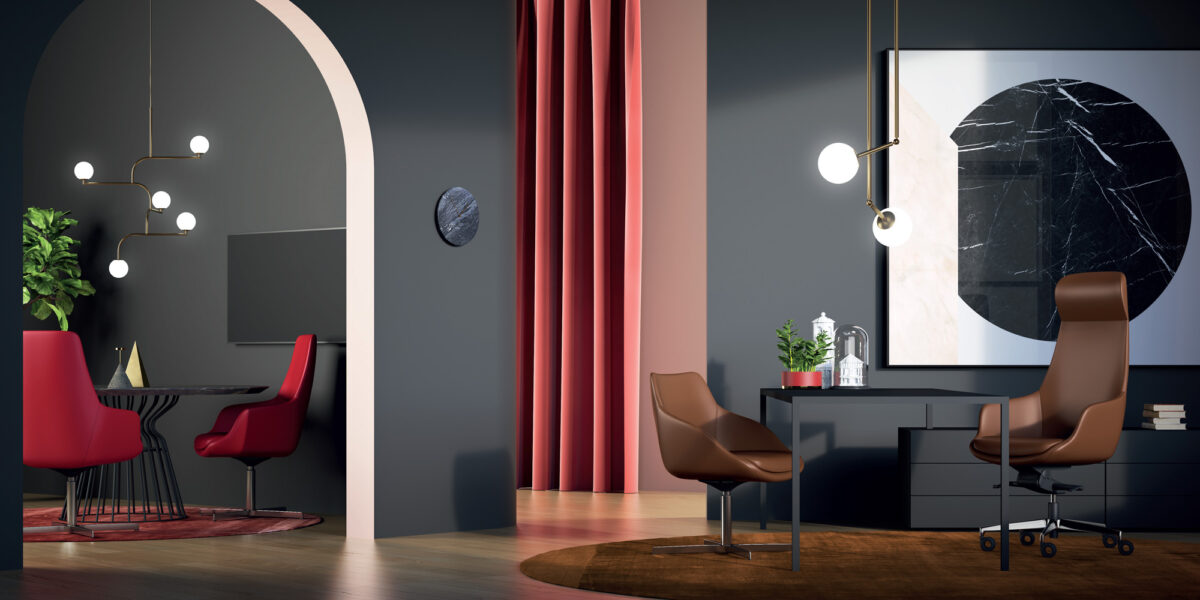Exhibition spaces, showrooms, points of sale, offices, waiting and sharing areas are no longer simple containers but become complex narratives in which the values of a brand take shape. The user goes from being a passive user of a physical structure to being the protagonist of an experience. To fully experience an environment it is necessary to involve all the senses: collaboration between sight and the other senses is indispensable for building our perception of reality. Every architectural experience is multisensory, made up of colours, tactile sensations, smells, sounds and tastes.
Looking at space
Sight is the privileged sense in the design and use of a space and consists of a series of elements: visual satisfaction, harmony and efficiency of the environment. When surrounding oneself with quality, comfortable and ergonomic furniture, it is important that it dialogues with the context in which it is placed. This aspect also derives from the choice of the colour of finishes and coverings, which must be based on aesthetic taste but must be aimed above all at the message and sensation that one wants to convey. Warm colours can evoke different sensations ranging from a state of comfort and warmth to a sense of hostility and anger; whereas cold colours tend to evoke calm. This is precisely why SITLOSOPHY® products are available in a wide range of finishes, upholsteries and colours.
Listening to space
We are often unaware of the importance of hearing in the spatial experience, even though sound provides important information about how a room is structured and articulated. While sight has more definition and a limited field of vision, hearing allows us to constantly check the environment around us at 360 degrees. Our ears allow us to know where sounds around us are coming from and to identify their sources with sufficient precision. While hearing may not be important in a small, private space, it is crucial when designing large spaces to reduce noise in public places and improve acoustics in auditoriums and theatres. In crowded, transitory spaces, products such as Itaca in its high-backed version can solve special privacy and soundproofing needs without the need for walls.
Quality to touch
Space can also be perceived through touch, arousing different sensations. A seat and a coffee table can give rise to contrasting sensations that can only be perceived by touch. These sensations can come from smooth surfaces, seams, curves and edges – quality can be touched. In order to achieve the highest level of quality, SITLOSOPHY® creates its collections with the utmost care, from design to production, through careful selection of raw materials. Upholsteries play an important role in the tactile experience, which is why the SITLOSOPHY® selection is varied. The SITLOSOPHY® range of textiles includes many upholsteries for public areas that have certain characteristics for safety and easy maintenance.
Smell the space
A lived-in space is full of smells that stimulate a complexity of sensations. This is why it is important that furniture is as neutral as possible or that it is are able to give off odours that envelop the space without overwhelming the user. SITLOSOPHY® collections are produced using top quality materials combined with techniques and products designed to guarantee maximum quality, such as water-based glues that are environmentally friendly and respectful of those who come into contact with them.
Tasteful environments
Taste seems to be a sense that is difficult to reconcile with space but which can be involved in designing corners for quick breaks but also spaces for business lunches or informal meetings during which get something to eat. SITLOSOPHY® proposes a wide rage of solutions to meet these requirements: from the «Domino» collection of modular seating that gives the possibility of alternating seats and tops, to the wide range of coffee tables that can be combined with any seat and type of use.













